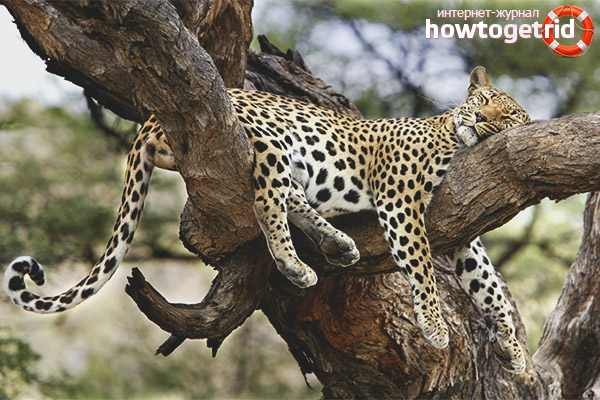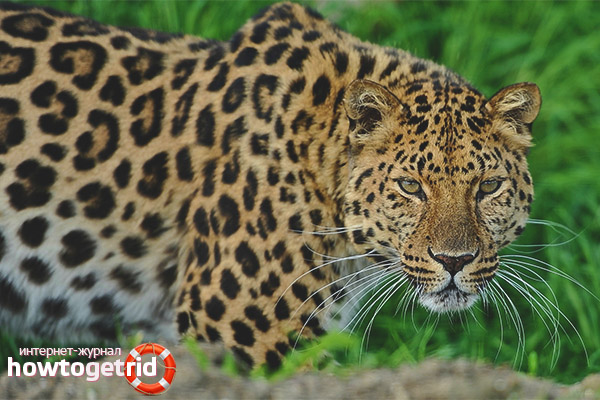The content of the article
Leopard belongs to the cat family and is considered a predatory mammal. To date, all representatives have been studied extensively, so there are no difficulties with the search for reliable information. We will consider where these individuals live, what they prefer to eat, what are their external characteristics, etc. You can make your own opinion.
Description
- These large-sized cats differ in size features from tigers and lions. By the way, the last animals are much more. If you follow the observations of experts, the females are slightly smaller than males, about a third of the body. The body is muscular and elongated in format, it is compressed from the side parts, it looks rather slender and flexible.
- The tail is elongated, occupies more than half the length of the body. The limbs are shortened, but strong and muscular. The nails are light, flattened on the sides, strongly bent. The head is relatively small in size, rounded in format. The forehead sticks out, in the front of the elongation is noticeable.
- The ears are rounded in shape, of medium size, set at a decent distance from each other. Rounded eyes of small diameter, the pupil is also round. Vibrissae are similar in appearance to black hairs, can be black and white or pure white. They extend up to 10 cm or more in length.
- As for the general description of the animal, its final characteristics depend on what gender the particular individual belongs to. Also important is the area of distribution and food. Those cats that live in forest parts are slightly less than individuals living in open areas.
- The length of the body of a grown leopard, with the exception of the tail, is 1-2 meters. The tail extends up to 1 m. And even more. By mass, adult members of the family reach 35-60 kg. (females) and 60-73 kg. (males). The height at the withers varies between 46 cm (females) and 75 cm (males).
- There are no gender differences. They only appear in the overall characteristics, so it is sometimes difficult to distinguish young animals. We can only say that young females, before reaching puberty, seem fragile, with an elongated and light head.
Wool cover
- As for the coat, it is shortened and relatively dense. Uniform in length over the entire body. It can be slightly lush in some areas when it comes to the cold season. The coat is shortened and coarse. According to external data, there are no particular differences in summer and winter. However, winter clothing is a little darker in pigmentation, dimmer and more even. The summer outfit is colorful and bright.
- Considering the color, it is worth saying that there are a lot of its variations. The hue can fluctuate, ranging from pale straw to bright red and even brown. Individuals of the Central Asian type are pigmented by gray-beige, while leopards that live in the Far East are colored yellow-red. Young animals are lighter than adults.
- Pigmentation is modified in proportion to geographical habitat, nutrition and many other aspects. The season of the year also plays a role. We emphasize that pigmentation in the anterior section of the muzzle is without spots, while in the area of the whiskers there are light inclusions. The forehead, ears and eyes have black spots of the same size. The same can be said about the lateral parts of the neck, cheeks and the area behind the ears.
- Ears from the back are pigmented in black. On the lateral parts of the body and back there are annular inclusions. They are also located in the area above the shoulder blades and on the hips.The legs and lower section of the abdominal region have solid and dark impregnations with clear contours. The tail is decorated with ring-lines that literally wrap it around it. Instead of lines, spots may be observed. Again, the formation of spots and their characteristics directly depend on the individual, this color is strictly individual.
- Those leopards who prefer to inhabit the southeastern part of Asia are otherwise called black panthers. They are not completely pigmented in black, but the large pigmentation section has just that color. The fur is thick, darkened, which allows individuals to disguise themselves in their environment. Interestingly, such leopards can appear simultaneously with offspring with specks. They are more aggressive, distrustful, distant.
- If we consider the population of mammals distributed on the island of Malacca, then more than half of the livestock is pigmented in black. The second part is occupied by animals in which incomplete melanism is revealed. It manifests itself in the fact that the spots are much larger and are closer.
Lifestyle
- These mammals prefer to hide from their eyes and not show. They settle in remote areas, but do not go far from human habitation. Males by the nature of their stay alone, while females raise offspring and are engaged in its education.
- Each individual individual occupies its territory, the size depends on arrogance and ability to conquer the land. As a rule, females can occupy up to 15 square meters. km The males are even bolder, they need about 50 square meters. km If individuals are heterosexual, they can enter each other’s areas without fear of being expelled.
- There are special marks by which individuals mark their territory. They can mark trees, certain plots of land, etc. Only those zones that have been selected for permanent residence and shelters are marked with urine. Almost all predators of this kind live permanently in their environment; they do not undergo migration.
- Some bachelor males can leave their homes and hit the road. They walk along streams, climb trees and overcome water obstacles. If there is a larger predator in front, the leopard will climb up and wait.
- Most often, leopards equip themselves with housing on the slopes. This arrangement of houses allows predators to have an excellent overview of the entire territory. As shelters, individuals often use caves, rocky canopies, stone placers, and even basal tree hollows.
- Often a predator can move with a graceful step. Often he is replaced by a gallop. When such an animal begins to run, its speed can develop up to 60 km / h. In addition, cats jump at impressive distances. The length of the jump can be up to 7 m. Leopards are excellent swimmers. Therefore, if necessary, they can overcome difficult obstacles in the water.
- On average, wild cats in the wild live about 10 years. As for the conditions of detention in a zoo or nursery, the individuals survive to 20 years without problems.
Diet
- All feline representatives are real predators. Therefore, the basis of the diet mainly includes ungulates. Individuals most often hunt roe deer, antelopes and deer. If there isn’t enough food in nature, cats may well enjoy various rodents.
- Leopards also attack monkeys, birds, and even reptiles. Sometimes such predators attack domestic dogs and livestock. Moreover, if the leopard is not disturbed, it will not attack a person. Otherwise, there were such cases when inexperienced hunters or tourists became victims of wild cats.
- A large predator often attacks foxes and wolves. If necessary, they do not even disdain carrion. Sometimes it can be observed that leopards steal food even from other predators. In addition, the considered individuals try to lead a solitary lifestyle.When hunting, the cat sits in ambush or sneaks up imperceptibly.
Breeding
- Individuals living in the southern territories are able to breed all year round. This applies to any subspecies of leopards. Predators that live in the Far East begin breeding in late autumn or early winter.
- In any case, during the breeding season, the reproduction of wild cats is accompanied by the fact that the males roar loudly. Often you can watch fights between males for the attention of the female. This behavior is inherent only in sexually mature individuals. Young growth always remains aloof.
- It is worth noting an interesting fact, young wild cats grow and develop much faster than tiger cubs. Therefore, at the age of 3 years, leopards gain full size. In addition, they have puberty. However, females mature a little earlier.
- After mating, the female carries offspring for 3 months. And in the end, only 2 babies eventually appear, more often 1. Newborn cats are completely defenseless and blind. At this time, the female tries to hide the young in caves and crevices. In advance, adult cats equip themselves with a home.
Enemies
The greatest danger to wild cats is wolves. The problem is that such individuals prefer mainly to keep in packs. Therefore, in areas where a small number of trees are present, leopards are in particular danger. Individuals often clash with hyenas, lions, bears and tigers. However, the greatest threat to the leopard is man.
It is worth noting that the largest population of such cats falls on the African expanses. Moreover, leopards are found in the mountains, savannahs, jungles and semi-deserts. They are not found only in the Sahara. Subspecies of such wild cats are common throughout the world. They can be found in the Far East in India, China, Sri Lanka and many other places.
Video: leopard (Panthera pardus)












Submit